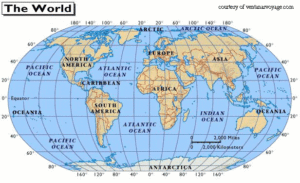St Paul MN is not in the Arctic, it just feels like it is. So just how far north are we?

According to Google Earth, my house in St Paul, MN is at 44.981692 degrees’ latitude. Which means it is about 0.9 miles south of half way (45 degrees) between the equator and the north pole. As a practical matter we are at 45 degrees latitude.
The latitude tells you how far north or south you are.
- Equator = 0 (Zero) degrees’
- North pole = 90 degrees’ latitude.
Each degree of latitude = ~69 miles (60 nautical miles)

How far north is St Paul, MN relative to other cities?
- Moscow Russia = 55 degrees = 690 miles north
- London England = 51 Degrees = 415 miles north
- Paris France = 48 degrees = 205 miles north
- Seattle Washington = 47 degrees = 140 miles north
- Budapest Hungary = 47 degrees = 140 miles north
- Rome, Italy = 41 degrees = 275 miles south
- New York City = 40 degrees’ latitude = 350 miles south
To state the obvious, the earth is a sphere which spins counterclockwise (west to east) on the axis between the north and south poles. Both poles (high latitudes) are very cold and pretty much frozen year round. Whereas areas relatively close to the equator (low latitudes) are warmer and almost never freeze. Also affecting the temperatures is proximity to the oceans and their currents. Whether we live east or west side of a mountains makes a difference in the weather we experience.
Maybe not so obvious is that the mid latitudes have a freeze thaw cycle. A freeze thaw cycle increases the weathering (erosion) of rocks and boulders. A freeze thaw cycle also limits the spread of some diseases that are carried by various insects, fungus and bacteria because they cannot tolerate the freeze condition. In fact, life expectancies are longer in areas with a freeze thaw cycle.
Another maybe not so obvious thing is in areas where it freezes, human civilizations require some infrastructure. Tough to survive longer than a couple days of freezing weather without shelter with a heat source. A house in Minnesota that is not sealed against the elements is dangerous where in a warmer location the same house would just be annoying.
So let me get to the point. Humans all over the world adapt to where we live. Where we live changes what it takes to adapt. People who live in different places require different infrastructure. People who live in different places have different local customs often because they live in a different place.
Let us say the kids are driving you crazy and you need them to not. Send them out to play is the time honored solution around the world. In a warm climate, send a kid out in the back yard is a good way to get them out of your hair. If it is freezing outside for weeks on end, other solutions to getting your kids out of your hair are necessary. Living in St Paul Minnesota is different than living in Florida or central Africa or Paris France or Brazil or wherever. But different does not mean better or worse. What is common sense in one place is crazy in another place.
It is easy to make judgements about people in other places but unless you are there and understand the environment there, be careful how you judge. I can tell you from experience that if you want to not care about the weather, ever, St Paul is not your place. The weather matters in St Paul. Life here embraces the weather. It is a great place to live.
Conclusion
St Paul is half way from here to there. It is cold but there are some advantages with that. But we need to be careful about our attitudes about where people live. We need to remember many of the differences we see between people from different places are because there is in fact a difference in the climate. Just saying.